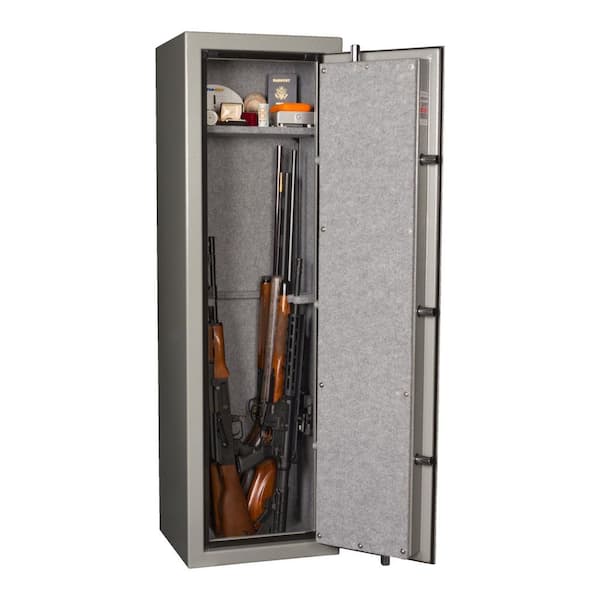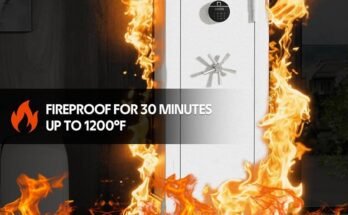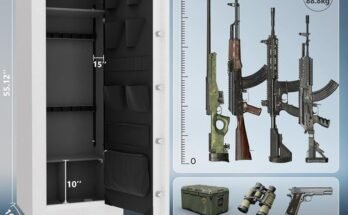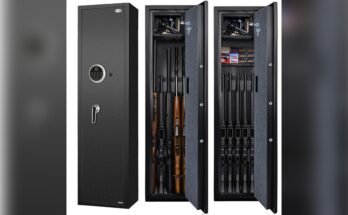Are you worried about protecting your long guns from fire damage? You probably already have a safe to keep your firearms secure, but is it enough when flames break out?
Knowing whether your long gun safe is fireproof can make all the difference between losing your valuable collection or keeping it intact. You’ll discover the truth about fireproof safes and what you need to look for to truly protect your guns from fire.
Keep reading to find out how to safeguard what matters most to you.

Fire Resistance Ratings
Fire resistance ratings show how well a long gun safe can protect its contents from fire. These ratings help buyers understand the safe’s ability to withstand heat. Not all safes are equal in fire protection. Knowing the ratings helps you choose a safe that meets your needs.
Common Fireproof Standards
There are several fireproof standards used to test safes. The most common are UL (Underwriters Laboratories) and ETL (Intertek Testing Laboratories). UL 72 is a popular standard for fire resistance. It rates safes based on how long they can protect against fire. Ratings like 30 minutes, 1 hour, or 2 hours show the safe’s endurance time. Some safes also have ratings for internal temperature limits. Lower internal temps mean better protection for guns and ammo.
How Ratings Are Tested
Testing involves placing the safe in a furnace with high heat. The temperature rises to over 1,700°F (927°C) or more. The safe stays in the furnace for the rated time. Inside temperature is measured to ensure it stays below critical limits. For guns and ammo, temperatures must stay low enough to prevent damage or explosion. After testing, the safe must remain locked and intact. This shows it can protect contents during a real fire.
Materials Used In Gun Safes
Long gun safes protect firearms from theft and damage. Their materials decide how well they resist fire. Fireproof qualities depend on what the safe is made of. Strong, heat-resistant materials keep your guns safe during a fire.
Steel And Fireproof Insulation
Steel is the main material in most gun safes. It gives strength and stops easy breaks. But steel alone does not stop fire heat. Inside the safe, fireproof insulation slows heat from reaching guns. This insulation can be special cement or board. It keeps inside temperatures low for a time. The thicker the insulation, the better the fire protection.
Intumescent Materials
Intumescent materials expand when heated. They grow and form a barrier against fire and smoke. These materials are often used as coatings inside gun safes. They help block heat and keep the safe cooler inside. Intumescent layers add extra fire resistance without adding much weight. This helps protect guns during a fire emergency.
Limitations Of Fireproof Gun Safes
Fireproof gun safes offer protection against flames and heat. They help keep firearms safe during a fire. Yet, these safes have limits. Knowing these limits helps set the right expectations.
Temperature Thresholds
Fireproof safes can only handle certain temperatures. Most safes protect up to about 1,200°F (650°C). Beyond this, the safe’s materials may weaken. The internal temperature might rise and damage the guns or ammo. Fires can reach much higher temperatures. This means no safe is fully fireproof at extreme heat.
Duration Of Fire Protection
Fireproof safes protect for a limited time. Common ratings offer 30 minutes to 2 hours of protection. If a fire lasts longer, heat will eventually enter. The safe’s insulation can only hold back heat so long. Longer fires increase the risk of damage inside. Choosing a safe with a longer fire rating helps.

Choosing The Right Fireproof Safe
Choosing the right fireproof safe is key to protecting your long guns from fire damage and theft. Not all safes offer the same level of protection. Some are better for fire resistance, while others focus more on security features. Understanding your needs helps you pick the best safe for your firearms.
Size And Capacity Considerations
Consider the number and size of your firearms. A safe too small will not fit all your guns comfortably. Leave room for future additions. Measure your longest gun before buying. Also, think about storing ammunition or documents inside the safe. Choose a safe with enough space to meet these needs.
Additional Security Features
Look for safes with strong locking systems. Electronic locks offer quick access and good security. Mechanical locks are reliable and do not need batteries. Some safes have reinforced doors and walls for extra protection. Fire resistance rating is important. A safe with a high rating can withstand higher temperatures longer. Also, check if the safe has a water seal to protect contents from water damage during firefighting.
Maintaining Fireproof Safes
Maintaining fireproof safes is key to keeping your valuables secure during a fire. Proper care ensures the safe works as intended. Simple checks and upkeep can extend the life of your safe.
Regular Inspections
Check your fireproof safe at least twice a year. Look for signs of damage or wear on the exterior. Test the locking mechanism to ensure it opens and closes smoothly. Watch for rust or dents that might affect fire resistance. Keep the area around the safe clean and dry to prevent moisture buildup.
Seal And Lock Maintenance
The seal around the door stops heat and smoke from entering. Inspect the seal for cracks or breaks regularly. Replace the seal if it shows signs of wear. Lubricate locks with a dry graphite powder to avoid jams. Avoid using oil, as it can attract dust and gum up the lock.

Alternatives To Fireproof Safes
Not all gun safes offer full fire protection. Alternatives to fireproof safes help protect your firearms in different ways. Some options focus on resisting heat for a short time. Others provide secure storage away from your home.
Fire-resistant Cabinets
Fire-resistant cabinets provide limited heat protection for guns and ammo. They are lighter and less expensive than fireproof safes. These cabinets can delay fire damage for up to an hour. They work best if a quick response to fire is possible. Their smaller size makes them easier to place in tight spaces.
Keep in mind, these cabinets do not protect against high heat as long as fireproof safes. They offer a good balance of security and fire resistance for many gun owners.
Offsite Storage Options
Storing guns offsite can reduce fire risk at home. Gun storage facilities often provide climate control and security. Some allow you to rent a locker or safe for your firearms. Offsite storage protects guns from fires, floods, and theft at your house.
This option suits owners with many firearms or limited home space. It separates guns from valuables stored at home, adding a safety layer. Check local laws before using offsite storage for firearms.
Frequently Asked Questions
Are Long Gun Safes Fireproof By Default?
Not all long gun safes are fireproof by default. Fire resistance depends on the safe’s construction and materials. Look for safes with a UL fire rating for verified fire protection.
How Long Can A Fireproof Gun Safe Protect Firearms?
A fireproof gun safe can protect firearms typically between 30 minutes to 2 hours. The duration depends on the safe’s fire rating and insulation quality.
What Materials Make A Gun Safe Fire Resistant?
Fire-resistant gun safes use materials like gypsum, concrete, and fire-retardant insulation. These materials help absorb heat and protect the contents from high temperatures.
Can A Fireproof Safe Withstand Extreme House Fires?
Fireproof safes are designed to withstand typical house fires up to their rated time. However, extreme fires may exceed the safe’s protection limits and cause damage.
Conclusion
Long gun safes offer strong protection for your firearms. Some models provide fire resistance, but not all are fully fireproof. Check the safe’s fire rating before buying. This rating shows how long it can withstand heat. Remember, no safe is completely fireproof forever.
Proper storage and placement help keep guns safe from fire damage. Choose a safe that fits your needs and budget. Stay informed and protect your firearms wisely. Safety matters most.



